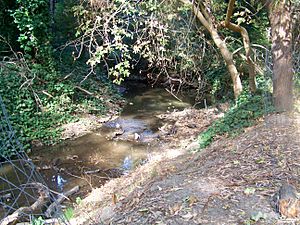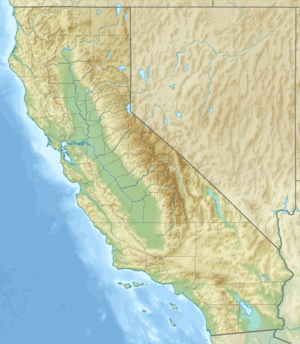San Pablo Creek facts for kids
Quick facts for kids San Pablo Creek |
|
|---|---|

San Pablo Creek just behind the El Sobrante Library
|
|
|
Location of the mouth of San Pablo Creek in California
|
|
| Native name | Spanish: Arroyo de San Pablo |
| Country | United States |
| State | California |
| Region | Contra Costa County |
| Physical characteristics | |
| Main source | Mulholland Hill Orinda, California 750 ft (230 m) 37°52′1″N 122°8′58″W / 37.86694°N 122.14944°W |
| River mouth | San Pablo Bay west of San Pablo, California 0 ft (0 m) 37°58′35″N 122°23′0″W / 37.97639°N 122.38333°W |
| Basin features | |
| Basin size | 41 sq mi (110 km2) |
San Pablo Creek is a stream about 18.7-mile-long (30.1 km) in Contra Costa County, California. It flows through a valley between two hills, the San Pablo Ridge and the Sobrante Ridge. These hills are part of the Pacific Coast Ranges east of San Francisco Bay.
The creek starts near Orinda and flows northwest into San Pablo Bay. It collects water from a large area, about 41 square miles (110 km2). Many smaller streams, called tributaries, flow into San Pablo Creek.
In 1919, a dam was built on the creek, creating the San Pablo Reservoir. Another dam was built in 1964 on Bear Creek, one of its tributaries, forming Briones Reservoir. The San Pablo Reservoir divides the creek into two main parts. For much of its journey, San Pablo Creek flows next to Wildcat Creek. The East Bay Municipal Utility District (EBMUD) uses less than 10% of its water from San Pablo Creek.
Contents
Exploring San Pablo Creek's Waterways
San Pablo Creek has many smaller streams that feed into it. These are called tributaries. Some of the named tributaries include Appian Creek, Bear Creek, Big Oak Creek, Cascade Creek, and Schoolhouse Creek. These streams help keep the main creek flowing.
Community Efforts to Protect the Creek
Many groups work to keep San Pablo Creek healthy. The city of San Pablo organizes cleanups. The Friends of Orinda Creeks also help clean up the area.
A group called the San Pablo Watershed Neighbors Education and Resources Society (SPAWNERS) does even more. They clean up trash and weeds, and they also work to restore the creek. Since 2000, SPAWNERS has built and cared for a special area near the El Sobrante Library. This area helps restore the creek banks and shows off native California plants. SPAWNERS also has an outdoor classroom project along Wilkie Creek, which is a tributary of San Pablo Creek.
Wildlife in San Pablo Creek
The dams on the creek have affected some fish, like the threatened steelhead. However, these fish can still survive in parts of the creek. Long ago, native Ohlone people lived along the creek. They left behind shell mounds, especially near San Pablo Bay.
The area where San Pablo Creek meets San Pablo Bay is called San Pablo Creek Marsh. This marsh is about 300 acres (1.2 km2) big and is full of amazing wildlife. You can find endangered animals here, like the California clapper rail and the salt marsh harvest mouse. Other animals include the shy salt marsh harvest sparrows and salt marsh yellow throats. These animals live in different parts of the marsh, from the salty bay water to where it mixes with the fresh creek water.
History of the San Pablo Canyon
In the early 1800s, the San Pablo Canyon was an open area where Mexican ranch owners let their animals graze. Later in the 1800s, a small train line, the California and Nevada, ran through the canyon. It went as far as Orinda. The company wanted to build the line all the way to mining areas in Nevada.
However, the railroad had problems with floods in the canyon every winter. So, it mostly carried people who wanted to go on weekend picnics from cities near San Francisco Bay. The train line through the canyon was eventually stopped when the Santa Fe Railroad took over the California and Nevada company.


